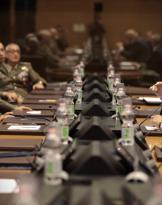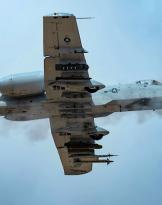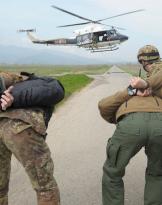The definition of international terrorism has been much debated within the United Nations and considerable differences have emerged on the distinction between terrorist acts and acts performed by the freedom fighters in the context of the struggles for the self-determination of peoples. These have determined the impossibility of providing a single and universal package of legal instruments suitable for preventing and suppressing terrorism. Recently there has been a reverse trend characterized by general collaboration to provide a compact response to the spread of Islamic terrorism.
With regard to the terrorist phenomenon, on the one hand, universal conventions have been drawn up which govern individual crimes traditionally associated with international terrorism, leaving aside the general data, while regional conventions have been stipulated which, while providing a general definition of terrorism, they are limited in their effectiveness. In all these normative texts an element that interests us and which we will shortly examine concerns the relationship between terrorism and the principle of self-determination of peoples.
From the years 60 to today we have witnessed a regulation of terrorist criminal conduct through international codification, in particular through the fourteen conventions developed within the UN framework. Before wanting to mention it, we must state that the strictly sectoral nature of the same is also demonstrated by the fact that most of these were concluded within the framework of specialized institutions of the United Nations such as the International Civil Aviation Organization (ICAO), l 'World Maritime Organization (IMO) and the International Atomic Energy Agency (IAEA). A fact that differentiates the normative productions concluded within the framework of the specialized institutes with respect to those concluded within the United Nations resides in the fact that only the latter refer expressly to international terrorism and therefore only within these it is posed the problem of distinguishing terrorist acts from those performed by freedom fighters.
Currently, as reported by the Regional Information Center of the United Nations based in Brussels, the Member States are negotiating a draft International Convention which integrates the framework of the existing international anti-terrorism instruments and which is based on the fundamental guiding principles already established in the previous Conventions.
The first three legislative texts concern all the terrorist acts that occurred in the air context: the 14 September 1963 Tokyo Convention on crimes and other acts committed on board aircraft, the 16 December 1970 Hague Convention for the suppression of illicit seizures of aircraft, and the Montreal Convention of 23 September 1971 for the suppression of illegal acts against civil aviation security.
With reference to the first Convention (on aircraft) it applies to all terrorist acts that undermine flight safety and gives the aircraft commander the authority to take reasonable measures, including restraint measures, against any person which in its well-founded opinion has committed - that is in the process of committing - an act against air safety if this is necessary to safeguard the safety of the aircraft and its passengers. Furthermore, the contracting States shall arrest the perpetrators of the crime and return the command of the aircraft to the rightful commander.
The second Convention (on illegal seizures) establishes that it commits a crime who, aboard an aircraft in flight, with the use of force or the threat of using it or with any other form of intimidation seizes or exercises the illegitimate control of that aircraft or attempt to do so. It is then envisaged that the States party to the Convention should punish the hijackings with severe penalties, without clarifying what this means. The clause of theaut dedere aut judicare and that, in any case, States assist one another in relation to criminal proceedings initiated under the Convention. This Convention was then supplemented by a supplementary protocol in the 2010: the result was the extension of the scope of application to the different forms of aerial hijacking including that which took place by means of modern technologies and the provisions of the Beijing Convention regarding the threat to the crime plot.
The third Convention (on civil aviation) has provided that it is a crime to carry out a violent act against a person aboard an aircraft in flight illegally and intentionally if this act could constitute a danger to the safety of the aircraft. Other crimes may have been foreseen such as the placement of the explosive device on an aircraft, the attempt of such a crime and the competition. The countries adhering to the Convention will have to punish these crimes with severe penalties and, again, the clause of theaut dedere aut judicare.
Wishing to remain within the air context, we must mention the Protocol for the suppression of illegal violent acts at international civil aviation airports, supplementary to the Convention for the suppression of unlawful acts against civil aviation security, of 24 February 1988 which extends the provisions of the Montreal Convention including terrorist acts in international civil airports.
We conclude the part relating to the Aviation Conventions by mentioning the Beijing Convention of 10 in September 2010 for the repression of illegal acts against international civil aviation, also known as new Civil Aviation Convention.
This normative text condemns the act of using a civil aircraft as a tool to cause death, injury or damage; to transport or to unload biological, nuclear chemical weapons or similar substances with the purpose of creating a harmful action, declaring that the threat or the act of attack, also computerized to the navigation systems of the aircraft are crimes and as such must to be punished.
A further category of acts considered as an expression of international terrorism governed by conventional law concerns the safety of maritime navigation. To this end, the Convention for the Suppression of Unlawful Acts against the Safety of Maritime Navigation and the Protocol for the Suppression of Unlawful Acts against the Safety of Fixed Platforms on the Continental Shelf, both signed in Rome on March 10 1988, are highlighted.
The Maritime Convention establishes for legal acts against international maritime navigation a legal regime similar to that already established for international aviation and provides that it commits a crime who unlawfully and intentionally takes possession or exercises control of a ship by force, of a threat or intimidation; anyone who performs a violent act against a person on board a ship if that act may constitute a danger to navigation safety; and whoever places a substance on board a vessel a device of destruction or performs other acts against the safety of the vessels. The 2005 Protocol intervened on this matter, bringing the regulatory framework up-to-date and condemning the use of a ship as a means to encourage a terrorist act, the transport by boat of materials destined to cause - or threaten to provoke - death, the serious injury or another damage to promote a terrorist action, and the transport of people who have committed terrorist acts. Specific procedures can be provided for the inspection of ships that are deemed to have committed an infringement under the Convention.
The Protocol on fixed platforms establishes a legal regime similar to that established for illegal acts against international aviation for documents against fixed platforms located on the continental shelf. This was also amended by the 2005 Protocol referred to above, adapting the amendments to the Convention for the suppression of illegal acts against the safety of maritime navigation in the context of fixed platforms located on the continental shelf.
In the field of atomic energy we signal the Convention on the physical protection of nuclear material (Convention on nuclear materials) signed in Vienna on October 26 1980. It condemns the detention, use and illicit assignment or theft of nuclear materials as well as the threat to use such materials to cause the death or injury of other people or substantial damage to property. Amendments to the Convention were also envisaged such as the legal constraint of the States members to protect the plants as well as the nuclear materials in peaceful internal use, storage and transport, and the bond of cooperation between the States in the context of rapid measures locate and recover stolen or stolen nuclear material, contain the radiological consequences of sabotage and prevent and combat attacks in this area.
The seven Conventions and Protocols examined so far have been concluded within the framework of the specialized Institutes of the United Nations. Let us now examine the international conventions adopted within the UN framework.
The first two, commonly characterized by being of the Conventions regulating very specific sectors, are the 14 December 1973 New York Convention on the prevention and repression of crimes against internationally protected persons, and the 17 December 1979 New York Convention against hostage taking.
The Convention on Diplomatic Agents in the first place defines an "internationally protected person" as a Head of State, a Minister of Foreign Affairs, an official or representative of a State or an International Organization entitled to special protection in a foreign State and his family . At the same time, it requires the parties to condemn and punish with appropriate penalties that take into consideration the seriousness of their nature, international murder, the abduction or other attack on the person or freedom of an internationally protected person, violent aggression against the aforementioned officer , at his private home or means of transport, the threat or attempt to commit such aggression, as well as any act that constitutes participation as an accomplice.
The Hostage Convention provides that those who kidnap, hold or threaten to kill, injure or continue to hold another person to force a third party, or a State, an international intergovernmental organization, a natural or legal person or a group of people to do or to refrain from doing any act as an explicit or implicit condition for the release of the hostage commits the crime of taking hostage under the Convention. On both these complexes the question of national liberation movements developed, in particular, during the preparation of the 1973 Convention, some States intended that the same was not applicable to national liberation movements by proposing to insert an article according to which "no provision of the present articles shall be considered for peoples struggling against colonialism, alien domination, foreign occupation, racial discrimination and apartheid in the exercise of their legitimate rights to self-determination and independence".
If it is true that within the Convention on Diplomatic Agents nothing has been foreseen in this regard it is equally true that Resolution no. 3166 / 1973 unanimously adopted by the General Assembly of the United Nations represents a compromise solution: "Anticipation of the law of self-determination and independence by peoples struggling against colonialism, alien domination, foreign occupation, racial discrimination and apartheid". This resolution was placed following the Convention and some States expressed their views on the aforementioned paragraph 4 of the resolution stating that the same could not and should not be considered as a basis of legitimacy for the commission of crimes regulated within the Convention under any circumstances not even the sense of the principle of self-determination. Other states argued instead that the Convention adopted should not feed the grip of colonialism and foreign domination.
A clear example in this sense is represented by the reserve affixed by the State of Burundi according to which it would not have applied the provisions relating to the obligation of States to provide for adequate penalties for the crimes regulated by the Convention and to process or extradite the alleged perpetrators of such crimes in the hypothesis in which such acts were carried out by a national liberation movement recognized by Burundi or by an international organization of which Burundi was a member since these facts would have been actions of struggle for their own self-determination.
Even with regard to the Convention on Hostages, some States stressed how the acts carried out by the freedom fighters, as different by definition and by objective from those carried out by terrorists, were to be considered excluded from the scope of application of the Convention. The Tanzanian delegate proposed the provision of an express clause of non-application of the Convention to acts carried out in a context of national liberation process against colonial, racist or foreign regimes, put in place by the national liberation movements recognized by the United Nations or by Regional organizations. To this the Western states responded, of the opinion that they do not provide for exceptions to the Convention based on the political cause of hostage taking.
The compromise was reached thanks to the Mexican delegate with the introduction of the art. 12 on the basis of which the cases of hostage-taking committed during armed conflicts as defined by the 1949 Geneva Conventions and the related additional Protocols of 1977 in which peoples struggle against colonial rule are excluded from the scope of the Convention. , foreign occupation or racist regimes in the exercise of peoples' right to self-determination as sanctioned by the Charter of San Francisco and the Declaration relating to the principles of international law concerning friendly relations and cooperation between States.
The other two Conventions that we are going to examine refer to terrorism in explicit and general terms, are the 15 December 1997 New York Convention for the suppression of terrorist attacks by explosives and the 9 December 1999 New York Convention for repression of terrorist financing.
The Convention on terrorist attacks using explosives creates a universal jurisdiction regime for the illicit and international use of explosives or other lethal devices in or against different public places with the intent to kill or cause serious physical injuries or with the intent to cause the destruction of the public place. In Article. 19 are then excluded from the scope of application of the Convention the activities of the Armed Forces engaged in a conflict and those undertaken by the same State Forces in the exercise of their official functions to the extent that such activities are governed by other rules of international law.
The Convention on the financing of terrorism commits the parties to prevent and combat the financing of terrorism, be it direct or indirect through groups that claim to have charitable, social or cultural purposes, or that are involved in illegal activities such as drug or arms trafficking . It is also stated that the States must hold the financial subjects criminally, civilly and administratively responsible. The identification, the freezing and the seizure of funds destined for terrorist activities as well as the sharing of funds with other States is also envisaged: banking secrecy is no longer sufficient justification for refusing to cooperate.
A further convention that we must have regard to examine in that of Montreal of 1 in March 1991 on the marking of plastic explosives for the purposes of detection. It, also known as the Convention on plastic explosives, has set itself the objective of controlling and limiting the use of unmarked and untraceable plastic explosives, a text that was negotiated following the 103 attack on the Pan Am World Airways of 1988. The States Parties are required, in addition to the effective control of the non-marked plastic explosives, to take the necessary and effective measures to prohibit the production of such warfare means, prevent their circulation inside and outside their territory and to exercise a strict control over the possession and transfer of explosives not marked produced and imported before the entry of the Convention. Of all the stocks it has been ordered to be destroyed or inert: for those not held by military or police forces, in accordance with the rule of international law, within three years, for those supplied to the military and police forces within 15 years.
We conclude this part on the conventional general international law by examining the New York Convention of 14 in September 2005 for the repression of acts of nuclear terrorism, also known as the Convention on nuclear terrorism. It covers a wide range of acts and possible objectives including nuclear power plants and nuclear reactors. It is established that criminals will have to be either tried or extradited and encourages states to cooperate in preventing terrorist attacks by sharing information and assisting each other in criminal investigations and extradition procedures.
The conventional law examined so far allows us to affirm that the juridical instruments prepared in this sense deal with disciplining reduced types of crime and not the problem of terrorism in an analytical manner. In some Conventions, even, there is no explicit reference to the terrorist purpose of the crime but they reveal the more general aims. Let us now examine conventional regional law, in particular that of our interest, namely that of the European Union. We must ensure that the regional convention has a physiologically reduced scope of application with respect to international law.
Historically, the first Convention adopted within the Council of Europe is that of 27 January 1977 for the suppression of terrorism. It was reached in order to make the extradition of the alleged terrorists easier by precluding the member states of the then Community the possibility of considering the crimes of terrorism as political crimes therefore not extraditable. And right here was a critical point of the normative text: the art. 2 foresaw the power and not the obligation not to consider the terrorist act a political crime for the purpose of extradition. The Convention then provided for the sanction of every act of violence directed against the life, integrity or freedom of persons as well as any other serious act against property when it puts in place a collective danger for individuals. This text was then amended by a protocol of amendment of 15 January 2003.
Chronologically it follows the 2002 / 475 / GAI Framework Decision of the Council of the European Union which, the 13 June 2002, introduces in the legal field some important definitions such as the terrorist crime: every international act defined as a crime based on the national law which, for its nature or context, it can cause serious damage to a country or to an international organization when it is committed in order to severely intimidate the population or force unduly the public authorities or an international organization to perform or refrain from performing any act, or destabilize seriously or destroy the fundamental political, constitutional, economic or social structures of a State or an international Organization.
To the purpose the art. 1 proposes a list of such acts prepared or committed on the territory of the European Union regardless of whether they are then carried out to the detriment of Member States, third countries or international organizations: the attacks on the life of a person that can cause the death; serious attacks on the physical integrity of a subject; kidnapping and hostage-taking; the extensive destruction of governmental or public structures, transport systems, infrastructures and fixed platforms located on the continental shelf or public places or private property that can endanger human lives or cause considerable economic losses; the seizure of aircraft or ships or other means of collective passenger transport or goods transport; the manufacture, possession, purchase, transport, supply and use of firearms, explosives, atomic, biological or chemical weapons, as well as, with reference to the latter, illegal research and development; the spread of dangerous substances, the cause of fires, floods or explosions whose effect endangers human lives; tampering with the interruption of the supply of water, energy or other fundamental natural resources whose effect endangers human lives; the mere threat to carry out one of the aforementioned pipelines listed.
Article. 2 then defines the terrorist organization as structured association of more than two people, established over time, which acts in a concentrated manner in order to commit terrorist crimes. The term "structured association" denotes a conviviality which is not established by chance for the commission of a crime and which does not necessarily include an articulated structure, formally defined roles for its members and continuity of the association itself. This Decision laid the foundations and defined the common parameters of cooperation in anti-terrorism matters.
The real start date of the European Union counter-terrorism strategy is the 2005. The Council established the four pillars of action from that moment: prevention, protection, prosecution and response. A common fact is that for all these pillars the strategy recognizes the importance of cooperation with third countries and international institutions.
In relation to the first pillar one of the priorities is represented by identifying and addressing those factors that contribute to radicalization and the processes by which subjects are recruited to carry out terrorist acts. To this end, the Council adopted a strategy to combat radicalization and revised recruitment, in the light of modern technologies, first of all social media, in June 2014.
The second pillar is the neuralgic point is the protection of citizens and infrastructures as well as the reduction of vulnerability to attacks: therein is therefore included the protection of external borders, the improvement of transport safety, the protection of strategic objectives and the reduction of vulnerabilities of critical infrastructures. An example of work in this area by the European Union is the legislation governing the use of Passenger Name Record (PNR).
The pursuit is the pillar perceived by most of us as the most important one. It expresses the intent to hinder the planning and organization capabilities of terrorists in order to bring them to justice. To guarantee these objectives, the European Union has focused on strengthening national capacities, improving practical cooperation and exchanging information between the police and judicial authorities (think of Europol and Eurojust), the fight against terrorist financing and deprivation to the terrorists of the means to organize attacks and communicate.
The last pillar is the preparation to manage and minimize the effects of terrorist attacks. The priorities in this area include the development of European coordination methods for crisis management, the review of the civil protection mechanism, the development of risk assessment of sharing best practices on assistance to victims of terrorism.
After the terrorist attacks in Paris in January 2015, the European Union decided to strengthen its response and accelerate the implementation of the measures agreed in previous years. On February 12 Member States agreed on the Riga Declaration to steer the work of the Union in the following months by asking for specific measures on three areas of intervention: ensuring citizens' safety, preventing radicalization and protecting values, cooperation with international partners.
In accordance with the guidelines expressed in the March session 2015 it was agreed to implement systematic controls based on risk assessment with reference to the Schengen framework, Europol was then invited to set up a unit to report Internet content that promotes extremism violent or terrorist, the same agency and the Commission were invited to make proposals on how to combat the trafficking of firearms, and the intention was expressed to adapt the PNR directive to IT-electronic advances.
In May 2015, to prevent money laundering and terrorist financing, the Council and the European Parliament have adopted new rules aimed at protecting citizens and safeguarding the internal market of the Union by ensuring that the financial systems of the Union itself is not used for terrorist purposes or for money laundering, which was then reworked in February 2016.
Also in the area of firearms trafficking, the first intervention in the October session of 2015 was then discussed again in March and June 2016












